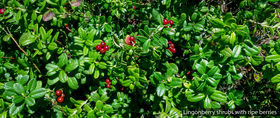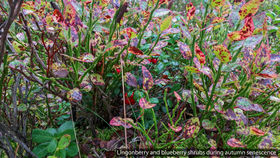True colors of berries
Berry picking is a great way to spend time outdoors exploring nature and, in addition their great taste, berries of lingonberry and blueberry are simply good for you as they are rich in vitamins and minerals. How could remote sensing assist in the popular recreational and commercial activity of berry picking?

Berries of wild forest shrubs are commonly valued for their health benefits and good taste. Consequently, berry picking is both a very popular rereatiocnal activity, as well as a commercially significant activity in Nordic countries. Lingonberry (cowberry) and blueberry (bilberry) are the two most typical berry-bearing species in Finnish forests and are recognized by most people by the distinct appearance of the shrubs and berries: lingonberry leaves are thick and glossy green, and berries are bright red, while blueberry leaves are notably thinner and matte green, and berries are indigo blue (Figure). While the berries of both species are widely picked, only a small fraction of the abundant yield is exploited on an annual basis. This may be partly because information on good berry picking locations is currently not publicly available but rather, people are likely to keep the best locations a secret for their own use.
Remotely sensed spectral and spatial data of forests may be collected using drones, airplanes, and satellites. Given that information on the species-specific spectral reflectance profiles and their variability over the growing season are available, remote sensing data could potentially be used to map berry-bearing species and even further, to predict berry yields. However, mapping forest floors’ species composition using spectral reflectance data of forest canopies is a tedious task and relies on detailed measurements at ground level, either in the field or in laboratory.
In general, the reflectance properties of forest berry species have rarely been the focus of spectral measurements and are yet to be implemented in mapping applications. However, a pilot study on the lingonberry and blueberry spectra showed that forest floors dominated by lingonberry and blueberry shrubs have distinct spectral signatures with strong seasonal variation during the phenological stages of leaf growing, flowering, berrying, and senescence. The study also showed that expanding the analysis range to encompass not only the visible spectrum, but also the longer wavelength near-infrared and short-wave infrared spectrums aided in differentiating the berry species by the position and shape of absorptance peaks. When exploring the spectra of the berries (Figure), the differences in the perceived colors between the two species were evident: although both berry species were relatively dark in most of the visible wavelengths, blueberries were slightly brighter from blue to green wavelengths, while lingonberries were substantially brighter in the red wavelengths. Beyond the visible spectrum, berries of lingonberry were shown to be consistently brighter than those of blueberry, indicating, e.g., a higher water content in blueberries. Furthermore, the development of berries was reported in the study to brighten the lingonberry shrubs considerably in the red wavelengths.
Remote sensing data from air- and spaceborne systems are integral for effective mapping and monitoring the change of forest landscapes and forest composition. For best results, however, more emphasis should be put on developing new ways to combine field and laboratory reference data, collected from different types of forest environments, plant species, and their phenological stages, with observations from above the tree canopy. Preliminary results on detection of forest berries using optical remote sensing data show potential to benefit a large number of people and businesses, and could provide valuable insights on, e.g., forest ecology.
It's good to keep in mind, that while new remote sensing technologies allow us to collect fundamental data of ecosystems with increasing detail, a forest is typically such a species-rich, structurally complex, and seasonally dynamic environment that a set of boots on the ground and a berry picking basket are still essential tools for understanding and experiencing the true colors of a forest.
For more information, please see: Forsström, P., Peltoniemi, J., Rautiainen, M., 2019. Seasonal dynamics of lingonberry and blueberry spectra. Silva Fennica. https://doi.org/10.14214/sf.10150
About the author: Petri Forsström is a doctoral researcher in geoinformatics in Aalto University.
Show other posts from this blog

Growth of the Peatlands
The restoration of drained peatlands is an efficient way of climate change mitigation. Satellite data enable restoration monitoring.Creating a checklist for a field work campaign
What’s there to consider when planning for a field campaign?
Kuusen neulaset heijastavat valoa samalla tavalla eri puolilla Eurooppaa
Tutkimus näytti ensimmäistä kertaa, että terveiden metsäkuusen neulasten spektriset ominaisuudet ovat samanlaisia eri puolilla Eurooppaa.

